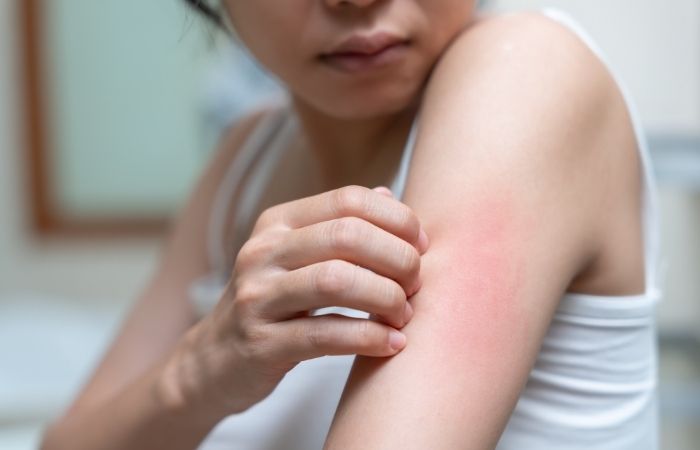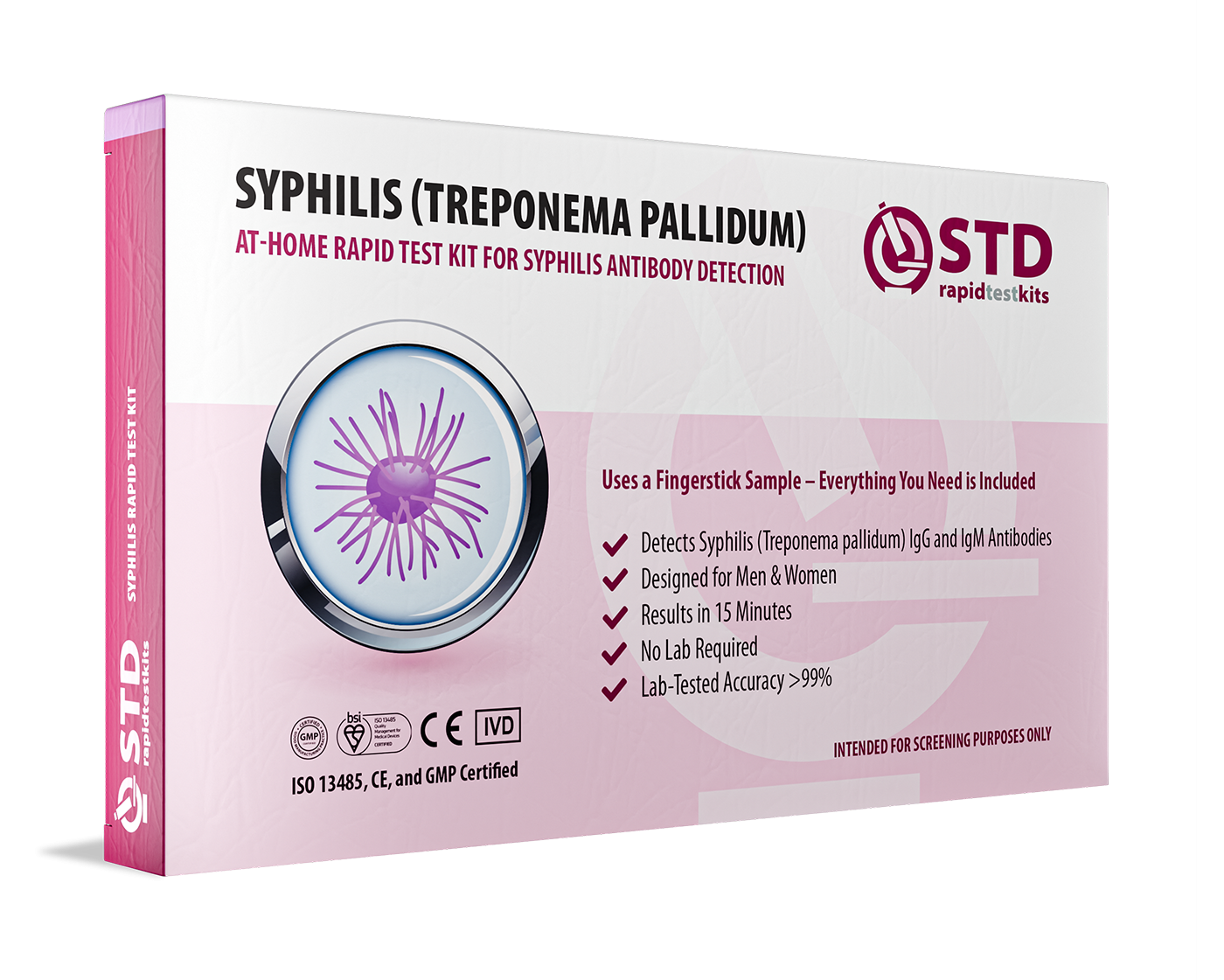Quick Answer: The 4 stages of syphilis are primary, secondary, latent, and tertiary. Symptoms shift from painless sores to full-body rashes to hidden nerve damage, and can be fatal if untreated.
Why Syphilis Still Spreads (Even When It’s Curable)
In a world where rapid STD tests are shipped to your door and penicillin can cure syphilis with a single injection, it seems wild that this infection still causes blindness, stroke, and even death. But here’s the hard truth: most people don’t catch syphilis because they’re reckless, they catch it because it doesn’t look dangerous.
Picture this: someone gets a small sore on their inner thigh. No burning. No smell. No discharge. Maybe they Google it, maybe not. The sore fades without cream, pills, or worry. They assume they’re fine, and move on. But syphilis doesn't. It hides, multiplies, and silently transitions from one stage to the next.
In 2023, the CDC reported that syphilis cases rose by over 70% in five years across all age groups, with congenital syphilis (passed from pregnant parent to baby) hitting alarming levels. The reason isn’t a lack of cure, it’s a lack of symptoms. And in a fast-moving hookup culture, no signs means no testing. No testing means progression.
Stage 1: The Painless Beginning You’re Likely to Miss
Stage 1 syphilis, called “primary syphilis”, begins with a single sore called a chancre. It usually appears 10 to 90 days after exposure. Here’s the kicker: it doesn’t hurt. The sore might show up on the vulva, penis, anus, lips, or inside the mouth or rectum. It’s round, firm, and often mistaken for a friction burn, razor bump, or even a canker sore if it’s oral.
Marcus, 36, said he noticed a small ulcer near the base of his penis after a camping trip with his partner. “I thought it was from the sand or rubbing,” he recalled. “It didn’t hurt at all. Then it vanished.” What he didn’t know was that syphilis had already entered his bloodstream. The sore healed, but the bacteria didn’t go away.
Here’s where most people go wrong: because the sore is painless and goes away on its own, it never gets diagnosed. No diagnosis means no treatment. No treatment means stage two is next, often without warning.
| Stage | Time After Exposure | Common Signs | Why It’s Missed |
|---|---|---|---|
| Primary Syphilis | 10–90 days | Painless sore (chancre) | Heals without treatment, often unnoticed |
| Secondary Syphilis | 6 weeks–6 months | Rash, fever, fatigue, sore throat | Mimics flu, allergies, eczema |
| Latent Syphilis | 6 months–20 years | No symptoms | No visible signs = no testing |
| Tertiary Syphilis | Years to decades later | Brain, nerve, organ damage | Linked only in hindsight, rarely tested for |
Table 1. Overview of syphilis stages and why each is frequently missed without testing.

People are also reading: Is Oral Sex a Potential Mode of HIV Transmission?
Stage 2: The Rash That Doesn’t Itch (But Should Terrify You)
Stage 2, secondary syphilis, often kicks in just as the chancre fades. This is when the infection spreads throughout your body. The classic sign? A reddish or copper-colored rash that usually hits the palms and soles. It doesn’t itch. It doesn’t hurt. It might not even look like a “rash.”
Other symptoms? Fever. Fatigue. Swollen glands. Sore throat. Muscle aches. A general “something’s off” feeling. Sounds like COVID. Or the flu. Or allergies. That’s the trap.
For Jai, 24, the rash started as tiny flat bumps on his hands after a weekend rave. “I thought it was something I touched,” he said. “Then I felt exhausted. But I’d been partying. It made sense.” The symptoms lasted a week, then disappeared. He never got tested. A year later, his vision blurred randomly, and doctors traced it to syphilis in his spinal fluid.
Secondary syphilis is when the bacteria quietly settle in your lymph nodes, eyes, ears, and brain, but without a single specific sign. The body tries to fight it, but without antibiotics, it can’t. You feel better. You assume it passed. It didn’t.
This is also when syphilis is most contagious. Even if you don’t feel sick, the infection can pass through oral, vaginal, anal, or skin contact. Condoms reduce risk, but if the sore or rash is outside the covered area, transmission is still possible.
If you’ve had a sore that disappeared, then weeks later felt like you caught “a weird virus,” you might not be wrong, but it might be syphilis.
Check Your STD Status in Minutes
Test at Home with RemediumSyphilis Test Kit

 For Men & Women
For Men & Women Results in Minutes
Results in Minutes No Lab Needed
No Lab Needed Private & Discreet
Private & DiscreetOrder Now $33.99 $49.00
Stage 3: The Silent Years (Also Known as Latent Syphilis)
This is the longest stage, and the most deceptive. After the rash and flu-like symptoms disappear, syphilis enters the “latent” stage. This means it’s in your body, but you feel completely fine. No sores. No fever. Nothing to report.
Latent syphilis can last months, years, or even decades. For some, it never progresses. For others, it quietly builds damage in the nervous system, major organs, bones, and blood vessels.
María, 44, found out she had syphilis only after applying for a job that required full blood screening. She hadn’t had symptoms in years. Her positive test was traced back to a relationship from her late 20s. “I never knew,” she said. “I never would’ve known if they hadn’t screened me.”
Testing during this phase is often accidental, done during prenatal checkups, blood donations, or visa medicals. Most people who are positive in this stage had no idea they were ever exposed. And that’s the danger: syphilis doesn’t knock. It waits.
If you think the absence of symptoms means you’re safe, syphilis is counting on that.
Stage 4: When Syphilis Hits Your Brain, Heart, and Spine
By the time tertiary syphilis sets in, the infection isn’t just in your blood, it’s in your bones, heart valves, spinal cord, and brain tissue. This stage can hit 10 to 30 years after the initial infection, and while rare thanks to antibiotics, it still happens, especially in people who were never tested.
Let’s be clear: this stage is brutal. It’s not about STI shame anymore. It’s about life-altering damage. People can go blind. They can lose memory function, suffer seizures, develop personality changes, or experience what’s called tabes dorsalis, a painful, staggering nerve degeneration that mimics MS. Heart valves can balloon or rupture. Aneurysms can develop silently.
Andre, 61, came to the ER with slurred speech and vision loss. Doctors suspected a stroke. But spinal fluid tests showed advanced neurosyphilis. His infection had gone untreated for over 25 years. “I didn’t even know I’d had syphilis,” he told his care team. “I thought I just got lucky.”
This stage isn’t just rare in textbooks. In low-access communities, with poor healthcare funding or high stigma, tertiary syphilis is still seen, and still killing. It's not a relic of the 1800s. It's alive in prisons, shelters, suburbs, and college campuses alike.
And here’s what no one tells you: not all tertiary symptoms are obvious. Some start with subtle numbness in the legs, a change in reflexes, or depression that doesn't respond to treatment. Others show up as eye inflammation or hearing loss. Many go misdiagnosed for years.
By the time someone connects the dots, irreversible damage has already been done.
What Testing Looks Like at Every Stage
Depending on which stage you're in, different tests may show different results. Syphilis isn’t always caught by one test alone. Most screenings use blood-based antibodies, which show up around 3–6 weeks after infection. But if you're very early, or you’re testing based on symptoms alone, a rapid test might miss it.
To increase accuracy, labs often do a two-step approach: a treponemal test to check for antibodies against the bacteria itself, followed by a non-treponemal test (like RPR or VDRL) to assess activity level. This helps confirm not just if you’ve ever had syphilis, but if it’s active now or already treated.
At-home tests can detect syphilis reliably if you’re past the 3–6 week window. Earlier than that, you risk a false negative, even if you’re infected. This is why many sexual health experts recommend retesting at the 6- or 12-week mark if exposure is suspected but symptoms are vague or absent.
| Test Type | What It Detects | Best Time to Use | Limitations |
|---|---|---|---|
| Rapid Syphilis Test (fingerstick) | Antibodies to syphilis | 3–12+ weeks after exposure | May miss early infections |
| RPR / VDRL | Current infection activity | Used alongside positive antibody test | May turn negative after treatment |
| FTA-ABS or TP-PA | History of infection | Good for confirming older infections | Stays positive even after cure |
| CSF testing (spinal tap) | Neurosyphilis | When neurological signs are present | Only used in advanced stages |
Table 2. Types of syphilis tests and what each is best used for during progression.
If you’re wondering what test to start with, most providers recommend a blood-based antibody test if you suspect recent or past exposure, even if you feel fine. The longer you wait, the higher the chances the test will be accurate.
If you don’t want to visit a clinic, or if privacy matters more right now, at-home test kits offer discreet options. These use a finger-prick blood sample and can detect syphilis in the same way a clinic does.
Don’t wait and wonder, get the clarity you deserve. This at-home combo test kit checks for the most common STDs discreetly and quickly.
Real Lives, Real Regret: When Symptoms Are Ignored
Some of the most heartbreaking cases of late-stage syphilis begin with mild, manageable symptoms that were brushed off. A sore dismissed. A rash ignored. A partner never told. A test never taken.
Jenna, 33, first noticed a sore after a casual encounter during her divorce. “I was embarrassed to even Google it,” she said. “I didn't want to be that person.” She delayed testing for months. The sore vanished. But by the time she got tested, she was in secondary syphilis and needed multiple injections to halt the spread.
Sometimes the damage isn't just physical. People who find out years later they unknowingly passed syphilis to partners carry immense guilt. Others face reproductive consequences, congenital syphilis can cause miscarriage, stillbirth, or lifelong disability in newborns if untreated during pregnancy.
In these stories, one pattern repeats: silence, shame, and delay. And all of it preventable, with a test that takes minutes.

People are also reading: Why Men Struggle to Admit They Have an STD
Can Syphilis Come Back After Treatment?
This is one of the most confusing questions people have, because the answer is layered. Once you’ve had syphilis and received proper treatment, the infection is gone. You’re not “permanently infected” like with herpes or HIV. But here’s the twist: you can get it again. And if you do, the body won’t automatically recognize it.
Unlike chickenpox, surviving syphilis doesn’t mean you’re immune. You can catch it from a new partner just like the first time. And because the symptoms might be even less noticeable the second time around, it’s easy to slip back into the same cycle of silence and late detection.
That’s why retesting matters, not because treatment failed, but because exposure risks don’t stop with a shot of penicillin. If your partner wasn’t treated, or if you’re in a new relationship, regular screening is part of staying clear. Think of it like changing your toothbrush after a throat infection. It’s not paranoia, it’s hygiene.
If you tested positive in the past, your doctor might advise you to skip certain tests (like the TP-PA) in the future, because they’ll stay positive for life. But current activity tests like RPR will still help monitor reinfection or relapse if symptoms reappear.
Check Your STD Status in Minutes
Test at Home with Remedium6-in-1 STD Test Kit

 For Men & Women
For Men & Women Results in Minutes
Results in Minutes No Lab Needed
No Lab Needed Private & Discreet
Private & DiscreetOrder Now $119.00 $294.00
For all 6 tests
Breaking the Stigma: Who Gets Syphilis?
Syphilis doesn’t care who you are. It doesn’t care about gender, orientation, relationship status, or number of partners. It’s been found in monogamous marriages, among pregnant teens, in retired folks reentering the dating scene, and in people who swore they were “careful.”
Here’s the uncomfortable reality: condoms reduce the risk, but they don’t eliminate it. The sores can show up in areas that aren’t covered, and oral sex, especially without barriers, is a major route of transmission. That’s why the idea of “low-risk” sex isn’t the same as no-risk sex.
Instead of shame, what people need is education. And choice. And access to affordable, fast, discreet testing. That’s what turns a 30-year hidden infection into a two-week blip. That’s what stops blindness, birth complications, and heartbreak in their tracks.
And that’s where we all come in, by refusing to treat STDs like secrets, by naming them without flinching, and by testing with the same regularity we check our teeth or blood pressure.
Your status doesn’t define you. But your choices can protect you, and the people you care about.
If you’ve ever had a sore, rash, or “weird flu” that didn't quite make sense, or if you're just between partners and want peace of mind, there’s no better time to check. Explore STD Rapid Test Kits and take back the power of knowing.
Why Syphilis Testing Should Be Routine, Not Reactionary
Too often, people wait for something scary to happen before they act. A partner confesses. A pregnancy test turns positive. A rash appears right before a big trip. But syphilis doesn’t wait for the right moment to surface, it follows its own timeline.
That’s why the CDC recommends syphilis testing as part of routine sexual health checkups for people with more than one partner, those with anonymous or new partners, and everyone living in areas with rising case rates (which is now, frankly, most of the U.S.).
Testing doesn’t mean you did something wrong. It means you care. It means you understand that invisible doesn’t mean harmless. And it means you’re not willing to let an ancient infection write the script for your body, or your relationships.
Whether you’re queer, straight, monogamous, poly, a late bloomer, or exploring your identity, syphilis doesn’t discriminate. And neither should access to care. If your insurance won’t cover a test, or your schedule won’t allow for a clinic visit, use what you have: a discreet, at-home combo test kit that shows you the truth in minutes.
It’s not about panic. It’s about power. And it starts with a finger prick and a few drops of blood.
FAQs
1. Can you really get syphilis from oral sex?
Yup. That “it’s just oral” logic? Doesn’t apply here. If someone has a sore in their mouth or on their junk, even if you can’t see it, the bacteria can pass. No ejaculation needed. It’s sneaky like that. Dental dams and condoms help a lot, but they’re not bulletproof, especially if the sore’s in a spot not covered.
2. How soon after sex would syphilis show up?
The first clue, usually a small sore, can appear as early as 10 days after exposure, or as late as 90. Most people clock it around the three-week mark. But the trick? That sore doesn’t hurt and often vanishes on its own. So unless you’re looking for it (or testing for it), you might never know it happened.
3. Is syphilis actually deadly or is that just scare talk?
It’s not scare talk. Syphilis won’t kill you overnight, but left untreated for years, it absolutely can destroy your brain, heart, eyes, and nerves. The good news? It’s 100% curable, if you catch it in time. The bad news? Many people don’t know they have it until serious damage is done.
4. Does syphilis always start with a sore?
In most cases, yes, but here’s the kicker: that sore can hide in places you wouldn’t expect. Inside the mouth. Up the rectum. Deep in the vaginal canal. So if you’re expecting something visible and painful, you might miss it entirely. That’s why we call it the master of disguise.
5. What does treatment look like? Do I need a bunch of pills?
Nope. For early syphilis, it’s usually one injection of penicillin, done. Quick, cheap, and wildly effective. If it’s further along, you might need more doses or follow-up tests, but it’s still treatable. Penicillin-allergic? There are backups. You won’t be left hanging.
6. I tested positive once, does that mean I’ll always test positive?
Kind of. Some tests (the ones that check if you’ve ever had it) stay positive forever, even after treatment. But there are other tests that tell if you’re currently infected. That’s why follow-up care matters. Don’t panic if an old test lights up, it might just mean you handled your business already.
7. What if I’m pregnant, can syphilis hurt the baby?
Yes, and this one is very serious. Syphilis can pass through the placenta and infect the fetus. This can cause miscarriage, stillbirth, or health problems that last a lifetime for the baby. But you can also stop it from happening. All of that stops when you test and treat early in pregnancy. It's one of the most important tests for pregnant women.
8. How often should I get tested for syphilis?
Think of it like an oil change for your sexual health. If you have new or multiple partners, test every 3–6 months. If you’re monogamous and steady, yearly might be fine. And if something feels off, a sore, a rash, a weird flu that lingers, test ASAP. No shame, just smart moves.
9. What should I do if I test positive?
Breathe. You’re not dirty. You’re not broken. You’re human, and syphilis is shockingly common. Call a clinic or provider, get the shot, and you’re usually good to go. Then tell your recent partners (there are anonymous ways to do this if needed). Testing them = protecting them. That’s real love, friend.
10. Can I have syphilis and not even know it?
Oh, absolutely. In fact, most people don’t know. That’s the biggest problem. It slips by quietly, especially in the latent stage. No symptoms. No drama. Just bacteria, hanging out in your system like it pays rent. Don’t wait for fireworks. Get tested. That’s how you win.
You Deserve Answers, Not Assumptions
Syphilis is sneaky. It doesn't make a lot of noise. It doesn't always look scary. But it spreads quickly, hides well, and waits for us to forget about it. That's how it wins: by making us doubt ourselves, make assumptions, and feel ashamed.
But knowledge is the antidote. And testing is the first move. Whether you’re worried about a sore, confused by a rash, or just want to be sure before starting something new, there’s zero harm in checking. And there’s everything to gain in catching it early.
Don’t guess. Don’t gamble. Order your combo test kit today and get the answers your body deserves.
How We Sourced This Article: We combined current guidance from leading medical organizations with peer-reviewed research and lived-experience reporting to make this guide practical, compassionate, and accurate.
Sources
2. Planned Parenthood – Syphilis 101
4. Syphilis – World Health Organization
5. Syphilis – STI Treatment Guidelines (CDC)
7. Neurosyphilis – StatPearls (NCBI Bookshelf)
8. Syphilis: Symptoms & Causes – Mayo Clinic
9. Syphilis: Nature Reviews Disease Primers
About the Author
Dr. F. David, MD is a board-certified infectious disease specialist focused on STI prevention, diagnosis, and treatment. He blends clinical precision with a no-nonsense, sex-positive approach and is committed to expanding access for readers in both urban and off-grid settings.
Reviewed by: Dr. T. Miles, MPH | Last medically reviewed: November 2025
This article is for informational purposes and does not replace medical advice.










